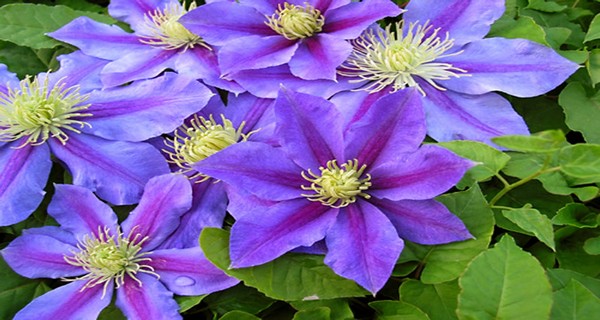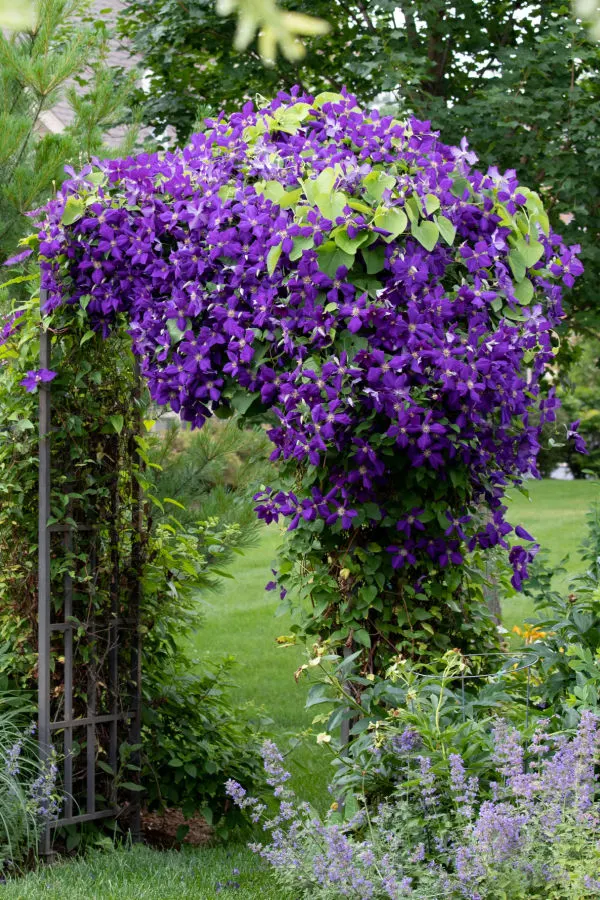Ad Blocker Detected
Our website is made possible by displaying online advertisements to our visitors. Please consider supporting us by disabling your ad blocker.
Who wouldn’t want their clematis to show off its blooms more often, maybe even giving another dazzling display this summer?
Clematis is just breathtaking when it bursts into full bloom. It’s like nature’s own artwork adorning fences, walls, light posts, and arbors, or gracefully trailing wherever it’s given a chance. With its vibrant colors and delicate floral scent, it adds a touch of magic to any space.
But for many gardeners, the magic fades too quickly. Most types of clematis bloom in the spring, and while they’re stunning for those few weeks, it’s a bit of a letdown when they’re just a mass of greenery for the rest of the summer.

Certainly, it’s not like the glossy leaves of the clematis lack charm or appeal. They do add a certain beauty and interest to the plant even when it’s not in bloom. But let’s be honest, when those flowers are in full bloom, the whole vibe of the plant changes!
But here’s the great news – you don’t have to sit around waiting until next spring to see those flowers again. Depending on where you live, with just a little extra TLC, you can usually coax your herbaceous clematis into blooming not just once more, but two, three, or even four more times in a single season!
How To Make Clematis Bloom Again & Again
When it comes to clematis, meeting three essential needs is key to coaxing out those additional bloom sets. Each of these needs carries its weight in importance. Sadly, if even just one is neglected, chances are the plant won’t grace us with a repeat performance – or if it does, it might be rather lackluster.
So, here are the three straightforward secrets that can unlock the potential for your clematis to flower repeatedly this summer, allowing you to relish those blooms like never before!
#1) Deadheading & Pruning – How To Get Clematis To Bloom Again
Deadheading involves removing fading or spent blooms from a plant, a practice that encourages it to bloom again. As blooms start to wither, they keep drawing energy from the plant. The longer they linger, the more energy they drain. While deadheading can prompt new blooms in just days for many annual flowers, with clematis, it’s about conserving energy to fuel a fresh flush of blooms about four to five weeks later.
Once you spot fading blooms, it’s time to snip them off. A trusty pair of hand pruners or garden scissors will make this task a breeze.
In addition to deadheading, giving your clematis a light pruning or trim after its blooming phase can also work wonders. Once your clematis finishes flowering, trim back the stems by about 8 to 12 inches to the last healthy node.
This action stimulates new growth and budding, putting your plant on the fast track to re-blooming. You can repeat this process each time your clematis finishes blooming throughout the season in hopes of coaxing out another round of blossoms.
Fertilizing – How To Get Clematis To Bloom More
Clematis plants are heavy feeders when it comes to nutrients, especially to fuel their blooming. Even with deadheading to conserve energy, they still require a replenishment of nutrients to support another round of blossoms.
The best way to recharge your clematis’s energy reserves is through fertilization. However, what you use as fertilizer matters greatly. It’s crucial to steer clear of fertilizers with excessive nitrogen content. While nitrogen is essential for promoting foliage growth, an excess of it can cause the plant to focus solely on leafy growth rather than flowering.
Instead, opt for fertilizers with higher phosphorus and potassium levels as part of the Nitrogen-Phosphorus-Potassium (N-P-K) ratio. Most fertilizers display this ratio on the packaging. For clematis, aim for N-P-K ratios falling within the 4-10-10 to 5-10-10 range. These ratios provide the right balance of nutrients to encourage robust blooming without overstimulating foliage growth.
Product Affiliate Link : Lily Bulb & Bloom Food
Increasing the phosphorus content in your fertilizer provides the necessary energy boost for blooming in your clematis. On the other hand, the elevated potassium levels aid in swift recovery and overall plant health.
With lower nitrogen levels, you ensure robust growth and foliage without compromising future blooms.
As for the frequency of fertilization, it’s ideal to fertilize each time your clematis completes a bloom cycle or right as it’s finishing.
This timing allows the plant to replenish its energy reserves and prepare for the next flowering phase. Just follow the recommended application rate provided on your fertilizer container for proper feeding. This way, you’ll ensure your clematis receives the nutrients it needs to thrive and bloom abundantly.
#3) Watering – How To Get Clematis To Bloom Again
In addition to failing to deadhead and fertilize clematis as they finish blooming, another big reason clematis fail to bloom again is due to a lack of water.

Besides neglecting to deadhead and fertilize clematis after blooming, another common reason for their failure to bloom again is inadequate water supply. Water plays a crucial role in encouraging clematis to bloom by keeping their roots properly hydrated. Insufficient moisture causes the roots to shrink, making it difficult for the plant to absorb essential nutrients needed for blooming.
During early spring, cooler temperatures and frequent rainfall typically provide sufficient moisture for clematis to develop their bloom set. However, as spring transitions into summer, temperatures rise, and rainfall becomes less frequent, posing a challenge for maintaining soil moisture.
So, how much water is enough for clematis? Ideally, aim to ensure your plants receive at least one inch of water per week throughout the summer. If natural rainfall doesn’t meet this requirement, it’s essential to supplement with watering. Without adequate moisture, the plant’s ability to bloom again is compromised.
You can go to the next page to read the rest of this article


